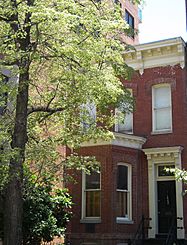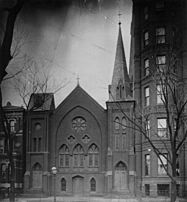Charlotte Forten Grimké facts for kids
Quick facts for kids
Charlotte Forten Grimké
|
|
|---|---|
 |
|
| Born |
Charlotte Louise Bridges Forten
August 17, 1837 Philadelphia, Pennsylvania, U.S.
|
| Died | July 23, 1914 (aged 76) |
| Spouse(s) | Francis James Grimké |
| Parent(s) | Robert Bridges Forten Mary Virginia Wood |
| Relatives | Margaretta Forten (paternal aunt) Harriet Forten Purvis (paternal aunt) James Forten, Sr. (paternal grandfather) Samuel Johnston (maternal great-grandfather) |
Charlotte Louise Bridges Forten Grimké (born August 17, 1837 – died July 23, 1914) was an African American activist, poet, and teacher. She grew up in Philadelphia, Pennsylvania, in a family that strongly opposed slavery.
Charlotte taught in schools for many years. This included teaching formerly enslaved people in South Carolina during the Civil War. Later, she married Francis James Grimké, a Presbyterian minister. He led a large church in Washington, D.C. for decades and was active in civil rights. Francis was also the nephew of famous anti-slavery activists, the Grimké sisters.
Charlotte's diaries, written before the Civil War ended, have been published many times. They are important because they offer a rare look into the life of a free black woman living in the northern United States before the war.
Contents
Early Life and Education
Charlotte, often called "Lottie," was born on August 17, 1837, in Philadelphia, Pennsylvania. Her parents were Mary Virginia Wood and Robert Bridges Forten.
A Family Against Slavery
Charlotte came from a very important family of abolitionists. These were people who worked to end slavery. Her father, Robert Forten, and his brother-in-law, Robert Purvis, were members of the Philadelphia Vigilance Committee. This group helped people who had escaped from slavery.
Her grandfather, James Forten, was a wealthy sailmaker and an early leader in the abolitionist movement in Philadelphia. Many women in her family were also active. Her aunts, Margaretta Forten, Sarah Louisa Forten Purvis, and Harriet Forten Purvis, helped start the Philadelphia Female Anti-Slavery Society. Her grandmother, Charlotte Vandine Forten, was also a founding member.
Charlotte's mother, Mary Virginia Wood, was born into slavery in the South. Her mother and her sisters were freed in 1832 by their father, James Cathcart Johnston. He was a wealthy planter from North Carolina. After being freed, they moved to Philadelphia.
Charlotte's School Days
Charlotte's mother passed away when Charlotte was young. She was then raised by different family members. In 1854, Charlotte moved to Salem, Massachusetts, to live with her aunt and uncle. There, she went to the Higginson Grammar School, a private school for young women. She was the only non-white student in a class of 200.
The school taught history, geography, drawing, and map-making. It also focused on teaching students how to think critically. After Higginson, Charlotte studied literature and education at the Salem Normal School. This school trained people to become teachers.
Charlotte loved reading and named William Shakespeare and John Milton as some of her favorite writers. Her first teaching job was at Eppes Grammar School in Salem. She became the first African American to teach white students in a public school in Salem.
Activism and Civil Rights
Charlotte Forten Grimké was a strong voice for civil rights. She joined the Salem Female Anti-Slavery Society. Here, she helped bring people together and raise money for the cause. She became an important leader in the fight for equal rights.
Charlotte sometimes gave speeches to groups about ending slavery. She also helped arrange talks by famous writers and politicians, like Ralph Waldo Emerson. She knew many other anti-slavery leaders, including William Lloyd Garrison, who edited The Liberator newspaper.
In 1892, Charlotte helped form the Colored Women's League in Washington, D.C. This group worked to bring African American women together. Their goals were to improve society and support the African American community. In 1896, she also helped start the National Association of Colored Women's Clubs. Charlotte remained active in these groups until she passed away.
Teaching Career
In 1856, Charlotte needed to earn money, so she took a teaching job at Epes Grammar School in Salem. She was a good teacher, but after two years, she returned to Philadelphia due to an illness. Around this time, Charlotte started writing poetry. Many of her poems were about activism. Her work was published in magazines like The Liberator.
During the American Civil War, Charlotte became the first black teacher to join the Port Royal Experiment in the South Carolina Sea Islands. After Union forces took control of these islands, Northerners set up schools. These schools taught formerly enslaved people who stayed on the islands.
Charlotte was the first African American to teach at the Penn School (now the Penn Center) on St. Helena Island, South Carolina. This school was created to teach enslaved children and later, children freed during the war. Charlotte worked with many freed people and their children. She wrote about her experiences in essays called "Life on the Sea Islands." These were published in Atlantic Monthly in 1864.
She became good friends with Robert Gould Shaw, who led the all-black 54th Massachusetts Regiment. Charlotte was there when the 54th Regiment attacked Fort Wagner. Shaw was killed in the battle, and Charlotte helped as a nurse for the surviving soldiers.
After the war, in the late 1860s, she worked for the U.S. Treasury Department in Washington, D.C.. Her job was to recruit teachers. In 1872, Charlotte taught at Paul Laurence Dunbar High School. A year later, she became a clerk in the Treasury Department.
Marriage and Family Life
In December 1878, Charlotte married Francis James Grimké. He was a Presbyterian minister and led the important Fifteenth Street Presbyterian Church in Washington, D.C.. This church was a major gathering place for African Americans. Francis was the nephew of famous white abolitionists, Sarah and Angelina Grimké. At the time of their marriage, Charlotte was 41 and Francis was 28.
On January 1, 1880, Charlotte and Francis had a daughter named Theodora Cornelia Grimké. Sadly, their daughter died less than five months later.
Charlotte helped her husband with his church work. She helped build important connections in the community. She also helped with charity and education efforts. Many church members were leaders in the African American community in Washington, D.C. Charlotte started a women's missionary group. She focused on helping to improve the lives of African Americans.
When Francis's brother, Archibald Grimke, worked as a U.S. consul in the Dominican Republic, Francis and Charlotte cared for his daughter, Angelina Weld Grimké. Angelina lived with them in Washington, D.C., and later became a writer herself.

The Charlotte Forten Grimké House in Washington, D.C., is a historic landmark. It is listed on the National Register of Historic Places.
Writings and Legacy
Charlotte Forten Grimké's last major writing was a response to an article in The Evangelist. The article claimed that black people were not treated unfairly in New England. Charlotte wrote back, explaining that black Americans achieved success despite huge challenges. She said they simply wanted to be treated fairly and with respect.
Charlotte kept a regular journal until she returned north after teaching in South Carolina. After that, she wrote less often. However, she did write about her daughter's death and her busy life with her husband. Her journals are very important. They are a rare record of what life was like for a free black woman in the northern United States before the Civil War.
In her diary on December 14, 1862, Charlotte mentioned "the blues" as a sad feeling. She was teaching in South Carolina at the time. She wrote that she came home from church feeling "very lonesome and pitied myself." She soon felt better. Later, she wrote about songs, like "Poor Rosy," that were popular among enslaved people. Charlotte said she couldn't fully describe how they sang these songs. But she wrote that the songs "can't be sung without a full heart and a troubled spirit." These feelings inspired many blues songs later on.
See also




